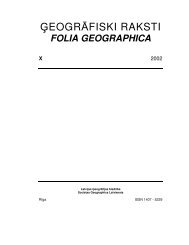eogrÄfiski raksti folia geographica xii - Ä¢eogrÄfijas un Zemes zinÄtņu ...
eogrÄfiski raksti folia geographica xii - Ä¢eogrÄfijas un Zemes zinÄtņu ...
eogrÄfiski raksti folia geographica xii - Ä¢eogrÄfijas un Zemes zinÄtņu ...
Create successful ePaper yourself
Turn your PDF publications into a flip-book with our unique Google optimized e-Paper software.
27<br />
NATURE RESEARCH<br />
3.5. Vegetation period<br />
Characteristic of Latvia’s climate is a half-year long vegetation period, when, <strong>un</strong>like the<br />
other half-year (dormant period), the plants are growing, blooming, producing fruits and<br />
ripening them. In terms of phenology it might be the time from the <strong>un</strong>folding of leaves to their<br />
falling [Schaefer, Tischler 1983; Leser 1997], yet more often this stage is restricted to climatic<br />
or agro-climatic interpretation – in the mid-latitudes it is associated with the period when the<br />
mean daily temperature exceeds 5ºC [Schultz 1995] or with the number of days when the mean<br />
daily temperature exceeds 10ºC [Ozenda 1994; Hendl <strong>un</strong>d Liedtke (Hrsg.) 1997].<br />
In accordance with the phenological observations [Latvijas dabas <strong>un</strong> vēstures kalendārs<br />
1967-2004], in most of Latvia the first signs of vegetation renewal (bud burst of several tree and<br />
shrub species, blooming of the willow, and the occasional decoration of bare spots by the first<br />
spring ephemeroids) are already seen in early spring, when the daily temperature rises above<br />
0ºC, and even earlier. The remnants of summer greenness and some blooms may be even seen<br />
<strong>un</strong>til the first winter frost in November. Yet, in general, the vegetation matches the features<br />
referred to in the definition of the vegetation period, when the daily temperature exceeds 5ºC. In<br />
most cases it sets in about 2-3 weeks after vernal equinox (mid-April) and comes to an end a<br />
month after autumn equinox (end of October).<br />
In the beginning of the described period the landscape outside coniferous forests is still<br />
dominated by gray color. Yet, the vegetation processes are already getting more intensive.<br />
Commonly the circulation of birch sap has started, and the shrub species widespread in Latvia,<br />
such as alder and hazel-trees, are blooming and the grass germinates. Soon after that leaves start<br />
to <strong>un</strong>fold, first the shrubs, then the trees. In the herb layer, the spring ephemeriods of nemoral<br />
zone (mainly Hepatica nobilis, Corydalis Halleri, Anemone nemorosa and A.ran<strong>un</strong>coloides) far<br />
and wide form blue, white and sometimes yellow flower carpets, which appear as bright<br />
colourful clusters in the generally gray landscape. In a short time the mean daily temperature<br />
rises by up to 10ºC (it usually occurs by the end of the first decade of May), all trees and shrubs<br />
have burst into leaf, the grasslands have become green.<br />
Thus, the beginning of vegetation period, a season less than one month in duration, which<br />
is typical of the change from a gray (except coniferous forests) early spring landscape with melt<br />
waters in the bare spots and isolated snow patches to a green and blooming landscape, might<br />
most appropriately be named Full spring. Afterwards, when daily air temperature rises above<br />
10ºC, the main phase of vegetation period sets in and lasts <strong>un</strong>til the end of the culminant phase<br />
of net radiation (end of July), encompassing the three following stages of summer (Figure 5).<br />
The first stage of the main phase of the vegetation period is pre-summer, a season of the<br />
renewal of highly active life processes, which, despite the still possible “return of cold”,<br />
distinguishes itself with a rapid increase of the number of blooming species and high biomass<br />
production. It follows from the phenological studies carried out in Estonia that during the next<br />
stage – early summer, the number of blooming species in the forest biogeocenosis of boreonemoral<br />
type (the dominant tree species is spruce, but in gro<strong>un</strong>d cover and shrub layer and tree<br />
stand, too, the species of deciduous broad-leaved forest hold a significant position) reach the<br />
maximum (shortly before/after summer solstice). Apparently, early summer and the following<br />
high summer are the main seasons of the annual course of biomass production, decomposition<br />
of dead biomass and biosphere-atmosphere gas exchange [Schultz 1981].<br />
In high summer the state of vegetation is much the same. Yet, as regards zonal forests in<br />
July, the phenospectra of the herb layer generated at the Vooremaa Forest Ecology Station in<br />
the growing season of 1973 showed hardly any not-yet blooming species, while the number of<br />
blooming species was gradually decreasing. Some time later, almost half of herb-layer species<br />
will have already come to the phenophase of developing and ripening of fruits or even seed<br />
dispersal, and a quarter will have reached pre-dormancy quiescence [Kannukene 1979]. In other<br />
words, during high summer the processes which ensure reproduction and dissemination of<br />
species and prepare the plants for survival during the period of winter dormancy and for<br />
resuming activity during the next vegetation period, gradually come to the forefront. Moreover,<br />
the biomass production decreases essentially and green mass dies off more intensively. Later on,<br />
in the second half of vegetation period, these processes are the main ones.

















